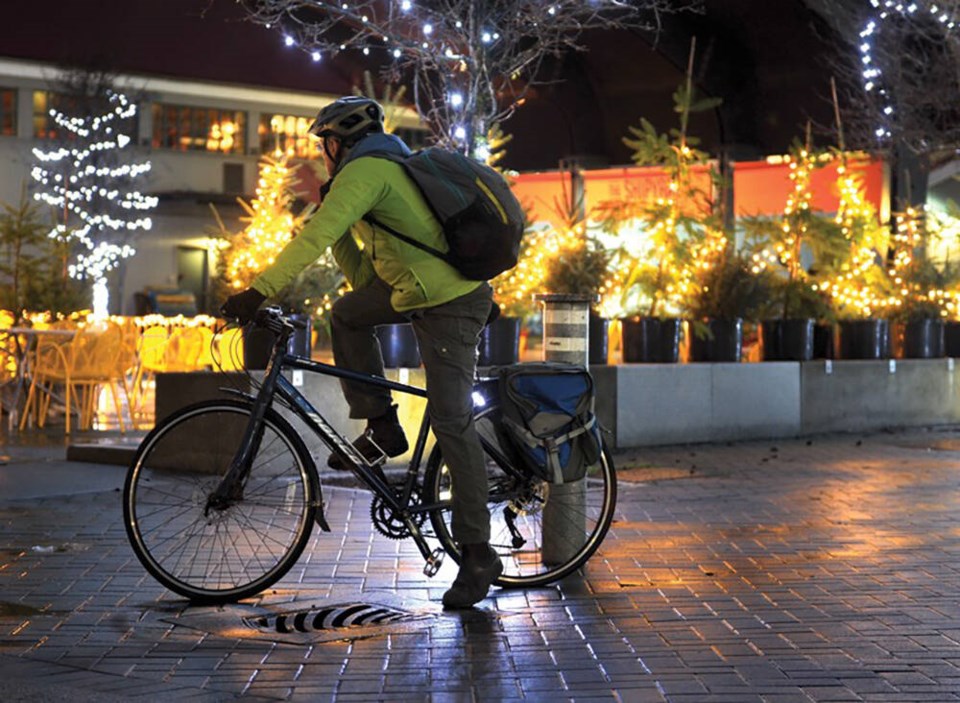I love cruising around the hood at night on my way back from yoga, the drug store or the Chinese food place to pick up take-out.
It’s great to be out walking or riding after dark, to feel and smell the earth cooling. You can spy the moon and Venus, take in the black silhouettes of the cedars against the midnight blue sky. I love to smell the soft scent of rain on the pavement after a hot day – the world winding down with you.
But dang, it’s dark. You know that kind of dark where you can’t see, dark? I live in Central Lonsdale, just three blocks from the main corridor. We don’t have enough street lights for me to be able to see where I am strolling or riding. There are overhead lights at St. Andrews and Ridgeway, but none mid-block. I walk four blocks home in the dark when I take the bus.
At least living in the City of North Vancouver, there are sidewalks. In the North and West Vancouver Districts, sidewalks are rare on side streets, and street lights are almost nonexistent. Mind you, bus service is so bad there, no one takes it anyway. Erk.
Yes, I have and use a bike light. Maybe it’s too wimpy, though because even with that light, I somehow always hit that stupid utility hole in the middle of the street – bump, bump. I often take a breath and think, well, I’ll have to trust that there’s nothing on the road that I don’t want to hit.
Yes, I have and use a flashlight while walking at night. Maybe it’s too wimpy, though, because even with it, I can still trip over the odd well-chewed stick that bowser abandoned on the sidewalk.
It’s a delicate balance because the only thing worse than no lighting is too much. People don’t like street lights shining into their house, and I don’t blame them. I wake up sometimes when my neighbour’s garage motion sensor light beams into my window at 3:07 a.m. Coyote time! Grumble, grumble.
We know that artificial light impacts the natural rhythms of birds, bats, insects and many animals – including humans. We don’t want to overly illuminate the world. It’s a real form of pollution. On the other hand, good lighting promotes walking and biking because it keeps people safer. In Canada, 60 per cent of pedestrian fatalities result from people inadvertently driving into other people walking at night. Being seen is essential.
The lamps on the middle path in Grand Boulevard Park are a good example of less intrusive lights that help people and their pups negotiate this curvy path. They are downlit to reduce stray light pollution. To improve them, they could be on motion sensors.
I picture motion sensor strip lights embedded in all sidewalks that “lead” you on your way as you progress down a street. Kind of like those lights that guide you to the exit doors on a plane, or the lights in two-star star hotels in Europe when you go to the shared bathroom. They could auto-detect passersby, light up, and at the same time, “alert” lights up ahead to turn on to light the way. Then they could auto shut off after a few seconds. Small-scale, low-powered LED smart lights can do this today.
If we want to encourage people to walk and roll, we must consider how that works after dark. Especially in northern latitudes where it’s dim in the morning and gets dark around four o’clock p.m. in winter. Street lighting must consider humans, not simply the requirements set by codes developed an eon ago for the metal growlers.
Happy summer solstice to all. Celebrate these long days by taking a walk or a ride in your neighbourhood well after it would usually be dark.
Heather Drugge is a sustainable transportation advocate who has used her bike for transportation for more than 20 years. She’s got an e-bike now, and maybe a jetpack next. [email protected]




